Wiring_Jumpers_Part_2_Types_and_How_we_Use_Them.pdf
Transcript:
[0m:4s] Hi I'm Josh Bloom, welcome to another video in the RSP Supply education series. In today's video we will pick up where we left off last time: talking about jumpers. If you have not seen the other video one jumpers, we will link it in the description below. Today we will show you some of the different types of jumpers that you might encounter and also how to install and use these jumpers. Keep in mind, the jumpers we are using today are specific to one manufacturer and are not universal.



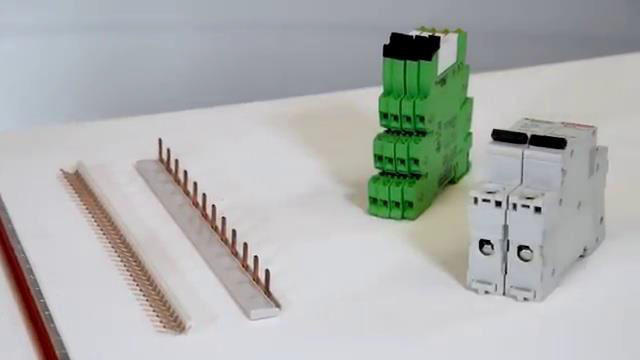
[0m:34s] The jumpers you use may differ from the ones we will show you today. The ones that we're showing you today are a Phoenix Contact brand. We use Phoenix Contacts because we find that they are very reliable and grate for industrial use cases. First, let's talk about terminal block jumpers or jumpers that are specifically designed for use with terminal blocks. As you can see here, I have a few different sizes, colors and shapes of terminal block jumpers.
[1m:3s] The great thing about using jumpers is that we can modify them for our specific use case.
[1m:10s] For instance, if we only have a length of three or four terminal blocks that we need to jumper, we can simply cut this length of jumpers to meet the need that we have. We can also clip out these pins that jumper into the actual terminal blocks. Let me show you how we use terminal block jumpers with terminal blocks. As you can see here, I have a set of five or 6 standard pass through terminal blocks.
[1m:35s] In this case, I would take the proper sized terminal block jumper and insert it in the location that is intended for jumpers on these particular terminal blocks.In this case they insert right at the top of the terminal blocks,
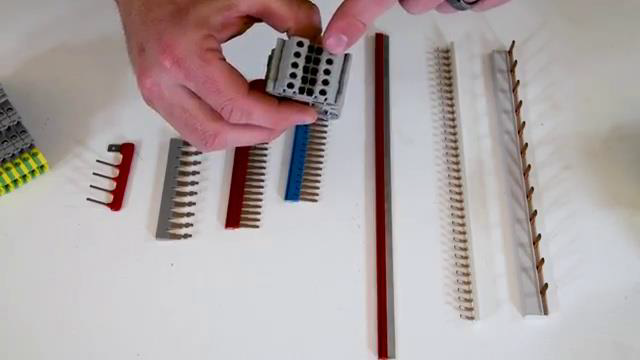
[1m:50s] and I push those jumpers in,
[1m:52s] and now I have a connection or continuity between these different terminal blocks. Obviously, in this case, I would cut off any excess so that I am only jumping the terminal blocks that I need to. So, for example, if we were using these terminals to distribute power, like we have shown in this particular industrial control cabinet where I have one wire distributing power to the many different circuit breakers, in this case, instead of running a power wire to each individual terminal block, I can run one power wire into one terminal block, which jumpers to the corresponding terminal blocks, which will allow me to distribute power to multiple devices with one input wire. So, remember with terminal block jumpers that we can modify, cut, and we must use the terminal block jumpers that are sized properly for the specific terminal blocks that we are using. Next, we're going to talk about jumpers that are specifically designed to be used with circuit breakers. As we have shown you a few times in this control panel, we have some jumpers that are being used with circuit breakers. Now, this particular jumper can also be used with terminal blocks, but we do have certain types of jumpers that are only designed to be used with certain types of circuit breakers. In this case, you can see there's a much larger jumper that is designed to be used with larger circuit breakers.
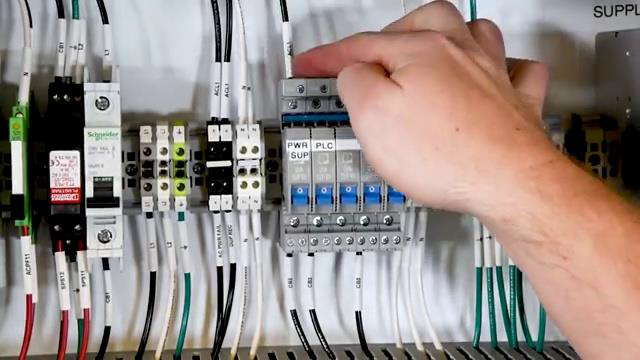
[3m:12s] Just like with our terminal block jumpers, we can modify these jumpers to cut them to length to fit our specific need. We can also cut out the individual jumper tines, if we want to skip one or two circuit breakers. This, again, also applies back to our terminal blocks. We can cut off each time to skip one or two or several circuit breakers or terminal blocks so the jumpers can be very easily modified. It is also a very good tip to make sure that we also mark on the jumper itself where the tines are actually going into the circuit breaker or terminal block.
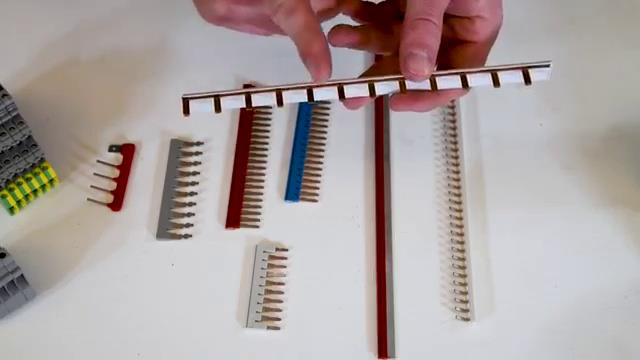
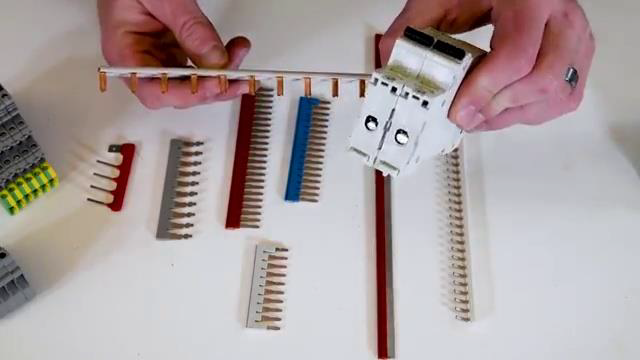
[3m:50s] One thing to keep in mind with circuit breaker jumpers: we need to make sure that they can handle the current that is going to be used through their particular circuit breakers that they are jumping.
[4m:0s] Now let's talk about a different type of jumper, which is known as a relay jumper again in this specific case, we are using a relay jumper for Phoenix Contact relays.
[4m:11s] There are other types of relay jumpers that are more specific to individual manufacturers.
[4m:17s] In this case, you can see that the relay jumper looks quite a bit different from the other types of jumpers that we have talked about. It is a slim metal copper bar that is used to be inserted into this specific type of relay.
[4m:32s] As you can see it slides right into these relays allowing us to jumper one relay to the next.

[4m:40s] Just like with all the other types of jumpers we've discussed today, these can be modified and cut to the specific length that you need for your application. However,

[4m:50s] with relay jumpers specifically this type of relay jumper, we cannot cut out specific sections if we want to skip certain relays. We need to use these right in a row.
[5m:1s] As well as the jumpers we've already discussed, we have a few other jumpers here. A few of these are designed again for types of terminal blocks. Different types of applications that you might see or encounter in the field. We also have a jumper here that is used for a specific type of PLC that jumpers several different points on that PLC together with one common conductor.
[5m:22s] So as you can see, jumpers allow us to more easily connect multiple points in many different industrial wiring scenarios such as power distribution or signal distribution or motors or many other different scenarios. Remember today that we discussed only just a few examples, but there are many different types of jumpers and scenarios which they can be used. For a full line of jumpers and thousands of other products, please go to our website. For more information or other educational videos, go to RSPSupply.com, the Internet's top source for industrial hardware. Also, don't forget: like and subscribe.




